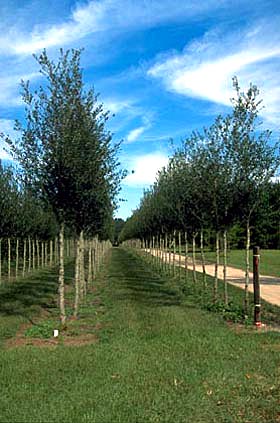Home > Nursery tree production > Root system > Field production > Field fertilization examples
Field fertilization examples

Fertilization on field grown shade trees is more an art than a science at this point in time (2005) because there is so little research to base recommendations on. Here is are three examples of fertilization programs that some field nurseries use successfully to grow shade and ornamental trees in the field.
Example fertilization program one: Live oak (Quercus virginiana) trees (#1 container) were planted in December 1997. Trees were fertilized using 8-10-10 in April 1998. Thereafter they received 20-6-12 five to six times per year, March or April through September each year. Fertilizer amounts started at 130 g 8-10-10 per tree, then 32.5 g 20-6-12, increasing as trees grew to 130 g 20-6-12 in the first year, 260 g (first fertilization) to 390 g (last fertilization) in second year, and 390 g in the third year. Trees were 2.4 inches caliper and 12 feet tall July 2000 which respresent normal nursery growth for field grown live oak.
Example fertilization program two: Two-hundred-forty seedlings of Southern magnolia (Magnolia grandiflora L.) were selected for uniformity from a group of approximately 500 plants and planted from 3-l (1 gal) plastic containers on 2.4 m (8 ft) centers into a Myakka Varient fine sand soil with a ph of 6.1-7.0 February 1987 in central Florida (USDA hardiness zone 9). Soil tests revealed K2O at 12 ppm K and P2O5 at 84 ppm. Trees were arranged in a randomized complete block design with five trees/treatment/block in eight blocks for a total of 40 trees/treatment. The five trees were positioned between two buffer trees at the end of each row. The treatments were six application rates of nitrogen applied as ammonium nitrate: 0, 20, 40, 60, 80, and 100 g N/m2 (4.2, 8.3, 12.4, 16.5 and 20.6 lbs N/1000 ft2)/year divided into nine equal applications. Ammonium nitrate was surface applied to a 0.9 m (3 ft) diameter circle monthly February through October each year for four years after planting beginning March 1987 and ending February 1991 and dolomitic limestone was surface applied at 112 g/m2 (1000 lbs/acre) once each year. Muriate of potash at 9.3 g K2O/m2 (83 lbs/acre) was broadcast at planting and applied every spring around each tree in a 0.9 m (3 ft) diameter circle. The water table fluctuated between 0.3 and 0.9 m (1-3 ft) below the surface during the study so trees were not regularly irrigated after they were planted. Weeds were periodically controlled with oryzalin and glyphosate in a 0.9 x 0.9 m (3 x 3 ft) square around each plant. Vegetation between trees was periodically mowed. Trees were root pruned with a shovel 20 cm (8 in) deep February 1988 in a 30 cm (12 in) diameter circle around the trunk. This mimics the practice many nurseries carry out to improve root branching in the root ball. Tree height and trunk diameter, at 15 cm (6 in) above soil line, were measured at planting and at the end of each growing season. Click here for results of this program.
Example fertilization program three: Sixty-six nursery-grown live oak (Quercus virginiana L.) with 11-12 cm (4-5 in) trunk diameters, measured 30 cm (12 in) above soil surface, were dug with a 1.5 m (60 in) diameter tree spade and moved about 65 m (200 ft) in March 1987 to the same site as described above. Trees were planted 6.1 m (20 ft) twenty feet apart on a berm about 30 cm (1 ft) above surrounding soil and mulched with a 8 cm (3 in) deep layer of cypress (Taxodium distichum L. Rich.) wood chips in a 1.8 x 1.8 m (6 x 6 ft) square around the trunk. The berm facilitated flood irrigation. Trees were periodically irrigated the first five months by flooding the swale between berms. Irrigation water did not cover the mulch placed around each tree. Beginning in May 1987 and continuing through June 1990, eleven trees received each of the following fertilizers in a randomized complete block design: two applications/year (May and Nov) of Milorganite (6 N-2 P2O5-0 K2O) (Milwaukee Metropolitan Sewage District, Milwaukee, WI), two applications/year (May and Nov) of Nutricote 180 (16 N-10 P2O5-10 K2O) (Plantco, Inc., Ontario Canada), one application/year (May) of Nutricote 360 (16 N-10 P2O5-10 K2O), two applications/year (May and Nov) of Osmocote (18 N-6 P2O5-12 K2O) (Scotts-Sierra Horticultural Products Company, Marysville, OH), and nine applications/year (Mar-Nov) of ammonium nitrate (33.5 N- 0 P2O5- 0 K2O). Fertilizer was surface applied at 29.3 g N/m2 (6 lbs N/1000 ft2)/year to a 1.8 x 1.8 m (6 x 6 ft) mulched area around each tree until May 1989 when the application area was increased to 3.7 x 3.7 m (12 x 12 ft). Because the rate remained the same at 29.3 g N/m2 (6 lbs N/1000 ft2)/year the amount of fertilizer applied per tree increased four-fold in May 1989 due to the four-fold increase in application area. Eleven control trees received no fertilizer. Trees were not root pruned after they were transplanted. Click here for results of this program.

